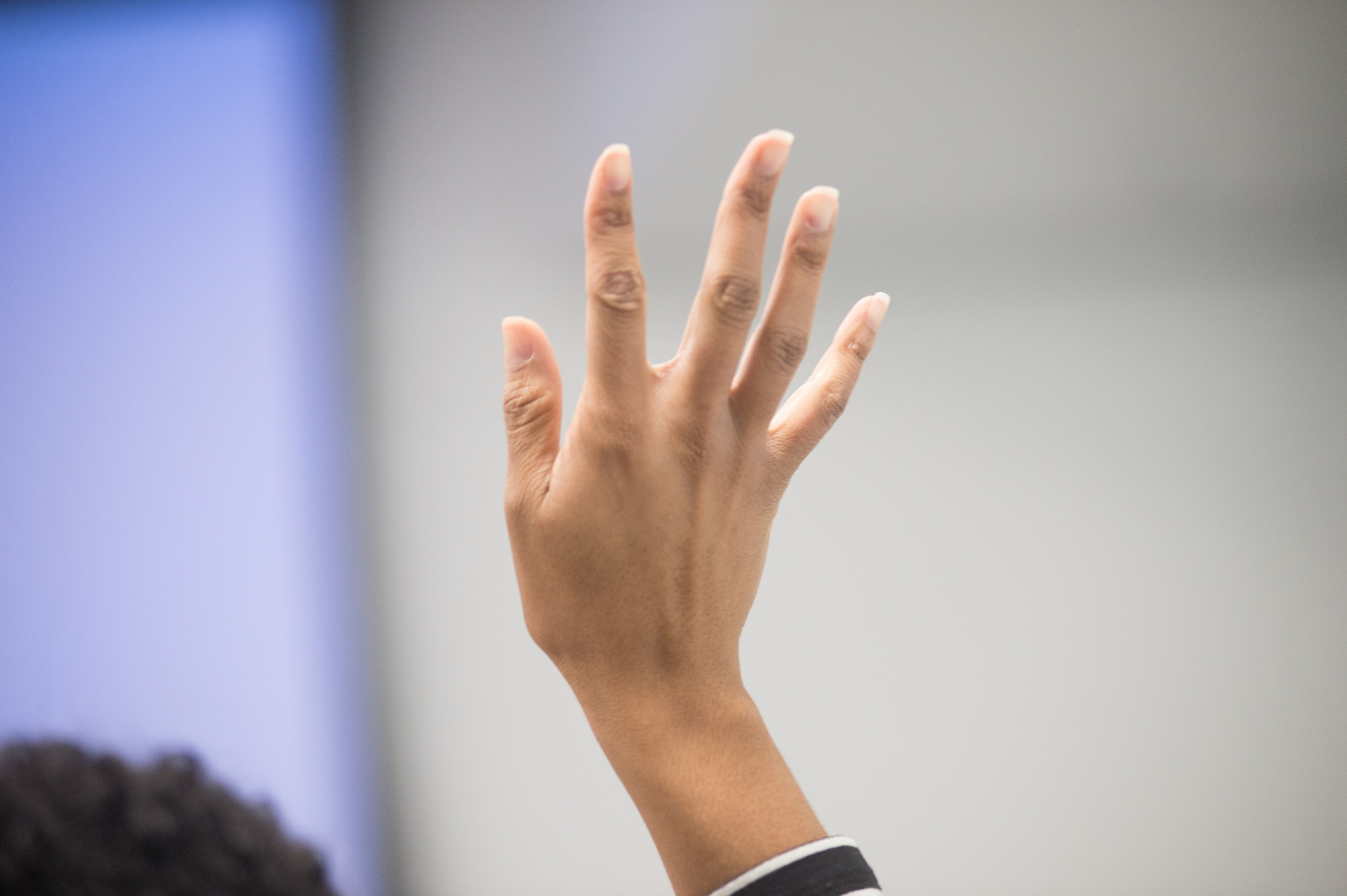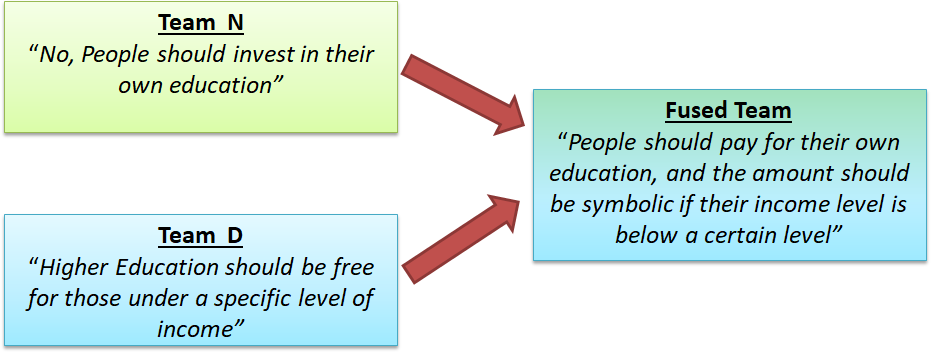It is always the Debate Moderator the one that grants the floor to a team member, a judge, or a person from the audience to speak. Once a speaker has begun, he is only obliged to give up the floor when ordered by the Debate Moderator or timer.
Members from debate teams must stand up when speaking - regardless of whether they are delivering a prepared speech, offering a POI / POA / etc., or asking a question. To avoid wasting time, it is recommended that they speak from their position rather than walking to a central stage.
Reading pre-written speeches should be avoided, except for snippets of data – statistics, historical events, third-person quotes, etc., or for referring to arguments made by the other side.
To avoid personalization of the debate, all speakers should refer to the rest of the teams in the third person ("The other team", "The speaking member from Team 2", "Our opponents") instead of statements like ("you" or "John, that is false"). Formality, however, is not needed.
Points of Information are well spread in most debate styles and are brief interruptions of the speaker by members of other teams to offer counter-arguments.
POIs can be requested only by members of teams other than the one that is speaking. To do that, the member of the other team raises his hand. The speaker to which the POI was addressed can choose to accept or not the offered POI. In the first case, he can simply say "Yes?" and temporarily yield the floor to the opponent. In the second case, he can say "No, thanks" or merely make a hand gesture dismissing the request and continuing.
A POI can last no more than 15 seconds.
Usually, most debate systems define a "protected time" of a speech, during which POIs cannot be made. Considering the length of our rounds, this protected time would be the first and last 45 seconds of the speech.

A Point of Order can be raised by any team member who believes the debate rules have been broken, and it must be done immediately when the violation is noticed.
The procedure for raising a Point of Order is the following:
- The debater wishing to make a POO stands up and says, "Point Of Order."
- The speaker stops speaking.
- The debater with the POO addresses the Debate Moderator and explains his case. During this period, timing is suspended.
- After hearing the case, the Debate Moderator makes a decision.
In general, Points of Order:
- Can interrupt a speaker.
- Are not debatable
- Cannot be amended or reconsidered
- Are decided by the Debate Moderator, with the decision being final.
Points of Agreement are an innovative feature of Agora debates directed at steering debates towards consensus building. The purpose of a POA is to state a team's acceptance of an argument proposed by a different team. This acceptance cannot later be withdrawn. To raise a POA, all members of the raising team must agree (there must be a consensus).
To prevent "yes, but…" scenarios that represent disagreement rather than agreement, A POA must repeat the argument of the opposing team exactly as it was originally stated. It cannot be distorted, adorned, nuanced, or in any way elaborated further. For example, a team cannot say, "We agree with the position that there's a moderate amount of fraud happening in subsidized higher education, but….". Either the statement made by the opposing team is accepted as it was stated, or there can be no POA on it.
The procedure for a Point of Agreement is:
- During their speaking turn, a team member proposing the POA explicitly states, "Our team agrees with the position/statement of team XXXX that : statement".
- The statement must be an exact repetition of an argument or position that the other team has made.
- The target team either replies "Accepted" (if the statement as quoted indeed reflects their position) or "Rejected" (if it does not). If the latter, a short explanation may be added.
Fusion of Teams is a unique characteristic of Agora Speakers Debates that encourages trying to reach a consensus.
At any point of the debate, two teams may reach an agreement and merge as one team, defending a common consensus position. In the example above, Teams N and D might agree to merge, defending a common position that "People should pay for their own education, and the amount should be symbolic if their income level is below a certain level":

When two teams fuse their position and become one team, an appropriate number of members of the resulting fused team must leave to maintain fairness and the rule that all teams must have the same number of members.
Fusing requires unanimous agreement by all the members of the two teams and proceeds as follows:
- The proposing team decides to offer a consensus position to another team. All the members of the proposing team must agree to the wording of the consensus position. Also, the proposing team must have pre-selected the team members who will leave if the offer is accepted.
- During any speaking turn of the proposing team, the speaker starts by addressing the target team and saying something like, "We would like to offer the following consensus position to team XXXX : ". Whatever formula is chosen, it must be made clear that this is a proposal for merging positions, the proposal must be worded clearly, and it must be directed to a specific target team.
- After the offer is made, the speaker proceeds with his regular speech.
- When the turn of the proposing team concludes, the moderator grants a pause of 1 minute in the debate for the target team to decide. During the pause, the target team deliberates and makes a decision, which can be only to accept or decline the offered consensus position. Acceptance must be unanimous, and it must be clear which team members from the accepting team will leave to maintain balance in the fused team.
- After the pause, regardless of whose turn to speak is, the moderator addresses the target team and asks if they accept or decline the offered position. The target team can only respond with acceptance or rejection; no arguments or speeches are allowed at this point.
- If the target team declines, the debate proceeds normally, with the moderator giving the floor to the next team in turn to speak.
- If the target team agrees, then the pre-selected team members leave, and a single fused team continues. This new team cannot speak during this round, as it is considered that it has already used its turn in point 3.
Re-splitting on fused teams is not allowed.
Fused teams are considered from the point of their fusion as a single team, enjoying a single speaking and cross-examination turn, with the standard timing applicable to any normal team.
The debate ends automatically with "Consensus" if no more teams remain after a fusion. If this happens during a debate contest, all the teams belonging to the final fused team are declared "Winners with Consensus". Contests should encourage this kind of outcome.
Note that if any kind of individual awards are available, they should be given to all the initial members of fused teams, regardless of whether they left the debate during the fusion to maintain team balance.
It is imperative for a healthy debate and club atmosphere to prevent any kind of insults, personal arguments, disrespectful speech, or raising the tone or shouting. None of these is allowed and can result in the disqualification of a team member or the team itself. Note that insults can be nonverbal (in the form of gestures, for example), and they still have to be penalized.
A Personal argument is any argument (or question, or comment) targeting the characteristics or attributes of a person of the opposing team or items outside the sphere of the debate, including (but not limited to ):
- Age, Gender, Sexual orientation or identity, Nationality, Race, Color, Religion, Ideology, Medical conditions.
- Educational or Professional Background.
- Lifestyle, preferences, hobbies, and interests.
- Publications or statements made outside of the debate. (Debates are self-contained, and the only arguments that can be opposed are those expressed during the debate itself).
Personal arguments are also arguments that are applied at generalizations of groups of people based on the above criteria, even if the addressee does not belong to the group. For example, "All Spaniards are lazy" is an ad hominem, even if no one in the debate is from Spain. Note, however, that offering objective non-judgmental research evidence concerning groups of people is allowed. For example, it's legitimate to claim that "People in Elbonia work only 12.6 hours per week, as opposed to 37.4 hours per week in France".
The debate moderator must act immediately upon hearing a personal argument. If this doesn't happen, the member to which the personal argument was addressed may raise his hand and state "Ad hominem" to compel the moderator to act, to which the moderator should either reply with "Disagree" or "Agree". If the moderator believes that a personal argument has been used, he or she may do one of the following:
- Warn the team member using ad hominem to refrain from future similar arguments.
- Stop the speaker from speaking, and deprive the offending team of their speaking turn during one round.
- Disqualify the offending team member and remove him from the offending team.
- Disqualify the team itself if members of the team persist in using personal arguments after one of their members has been disqualified for that reason.
- Terminate the debate itself if he sees that it has devolved into an ad hominem match.
A different kind of less severe but equally unacceptable behavior is:
- Constantly interrupting other speakers with spurious POIs or fake POAs
- Using stalling to "eat into" the other team's time, especially during the cross-examination rounds.
- Being persistently overtime.
- Breaking or abusing the rules
Evidence are facts, pictures, videos, data, quotes, etc., that support a speaker's argument.
The following rules apply to evidence:
- Each piece of evidence must be clearly separated from the speaker's own opinion and from other pieces of evidence.
- All evidence should be identified, sourced, and independently verifiable. This explicitly disallows "abstract or fuzzy evidence" in statements similar to "Research shows that …". Instead, such statements should be reformulated as "Research done by in shows that …"
- Evidence may not be distorted, misquoted, partially quoted, or quoted out of context. Such behavior is considered unacceptable.
- All evidence used should be made available to the other teams, the audience, and the judges, so that any of them can make use of it during their speaking turns. This means, for example, that if you use a printed chart to make a point, the printed chart must be placed in a place inside the room where others can take it to use it.
- Upon request by any other team or the judges, the evidence used must be provided in a detailed form and in writing. If the evidence is too long, at least one page of it must be available.
- Each piece of evidence should provide at least the following information:
- Author's name
- Author's qualifications that are relevant to the topic at hand.
- Complete bibliographic source information, including date and page number
- In the case of Internet sources, the full URL and the date of access
- Team members cannot receive any external coaching during the duration of the debate.
- Interruption of speakers by the audience or other team members is not permitted and should be handled by the Debate Moderator. Cheering is not allowed.